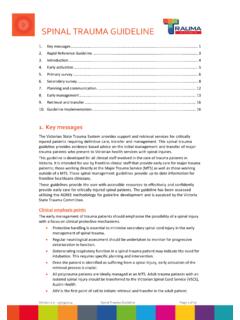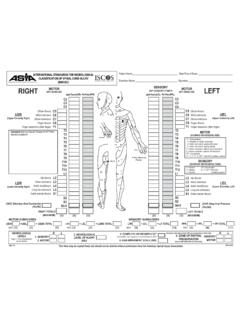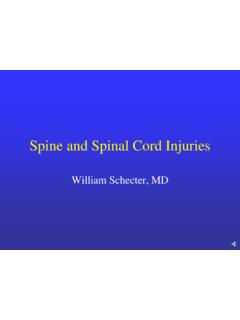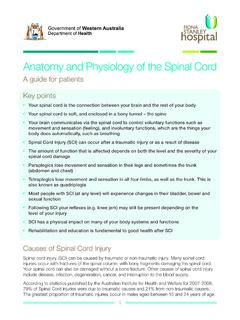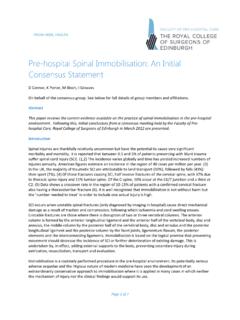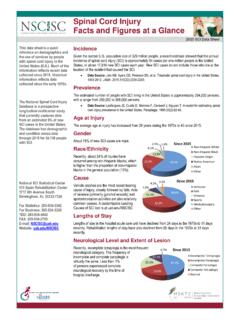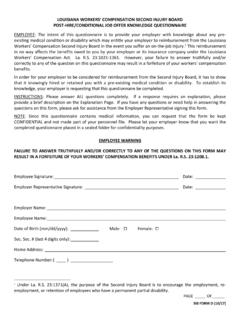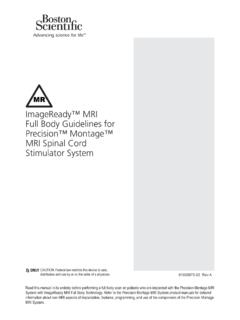Transcription of TRAUMATIC BRAIN INJURY GUIDELINE
1 TRAUMATIC BRAIN INJURY GUIDELINE Version - 25/09/2014 TRAUMATIC BRAIN INJURY GUIDELINE Page 1 of 30 1. Key messages .. 1 2. Overview .. 3 3. Introduction .. 4 4. Early activation .. 5 5. Primary survey .. 5 6. Secondary survey .. 8 7. Planning and communication .. 11 8. Early management .. 13 9. Retrieval and transfer .. 21 10. GUIDELINE Implementation .. 22 1. Key messages The Victorian State Trauma System provides support and retrieval services for critically injured patients requiring definitive care, transfer and management.
2 This TRAUMATIC BRAIN INJURY GUIDELINE provides advice on the initial management and transfer of major trauma patients who present to Victorian health services with severe injuries. This GUIDELINE is developed for all clinical staff involved in the care of trauma patients in Victoria. It is intended for use by frontline clinical staff that provides early care for major trauma patients; those working directly at the Major Trauma Service (MTS) as well as those working outside of a MTS. These guidelines provide the user with accessible resources to effectively and confidently provide early care for critically injured patients.
3 They provide up-to-date information for front-line healthcare clinicians. The GUIDELINE is evidence based, has followed the AGREE methodology for GUIDELINE development and is auspiced by the Victorian State Trauma Committee. Clinical emphasis points TRAUMATIC BRAIN INJURY is a significant cause of mortality in Australia Primary and secondary insults can result in significant INJURY and early management to prevent further BRAIN INJURY should begin at the scene. Minimising secondary BRAIN INJURY is best achieved by avoiding periods of hypoxia or hypotension.
4 Maintaining adequate ventilation and cerebral perfusion is essential. Early activation of the retrieval process is crucial once it is identified that the patient has suffered from a major trauma. TRAUMATIC BRAIN INJURY GUIDELINE Ver. - 25/09/2014 TRAUMATIC BRAIN INJURY GUIDELINE Page 2 of 30 Time to definitive care at a neurosurgical specialist centre is crucial and ultimately may influence patient outcomes. TRAUMATIC BRAIN INJURY GUIDELINE Ver. - 25/09/2014 TRAUMATIC BRAIN INJURY GUIDELINE Page 3 of 30 2. Overview TRAUMATIC BRAIN INJURY GUIDELINE Ver.
5 - 25/09/2014 TRAUMATIC BRAIN INJURY GUIDELINE Page 4 of 30 3. Introduction Head INJURY is a common feature of major trauma and patients with a moderate or severe head INJURY have a higher mortality as well as a higher morbidity, with victims often being left with a permanent neurological disability. The percentage of major trauma patients who have sustained a serious head INJURY has remained stable over the years, and accounted for of hospitalised major trauma patients in 2011 The mechanism of INJURY , however, has changed for this group of patients.
6 Motor vehicle crashes accounted for of severe head injuries in 2011 12 compared with in 2005 06. The decrease in severe head injuries could be attributed to improvements in INJURY prevention including reduced speed limits, speed reduction campaigns and improved car design such as airbags and anti-lock braking systems. Pedestrians and pedal-cyclists comprised of severe head INJURY cases in 2011 12 compared with in 2005 06. In contrast the percentage of major trauma patients with a severe head INJURY sustained by elderly patients in a low-fall mechanism has increased from in 2005 06 and to in 2011 12.
7 In patients with multisystem injuries, the head is the most frequently injured part of the Many incidents of TRAUMATIC BRAIN INJURY (TBI) occur in rural areas where access to medical services is limited and a delay in definitive care may occur. It is important for health professionals working in these isolated areas to be aware of how to manage acute patients to prevent any secondary INJURY . Patients presenting with TBI can be a challenging group to deal with. They are often confused and combative, which can make assessments and even the most basic clinical tasks difficult and time consuming.
8 TBI is generally classified according to the Glasgow Coma Scale. A GCS score of 13 15 is considered a mild INJURY ; 9 12 is considered a moderate INJURY , and 8 or less as a severe TBI. The GCS is universally accepted as a tool for TBI classification because of its simplicity, reproducibility and predictive value for overall prognosis. However, its use may be limited by confounding factors such as intoxication and ongoing medical treatment such as sedation and/or paralysis. There are two types of BRAIN INJURY : primary and secondary. Primary INJURY occurs at the moment of the TRAUMATIC incident and reflects the mechanical events in the BRAIN at that instant.
9 There may be gross disruption of BRAIN tissue that is not Common mechanisms include direct impact, rapid acceleration/deceleration, penetrating INJURY and blast waves. Secondary INJURY can occur minutes, hours, days or even weeks after the initial INJURY and the damage can be averted or lessened by appropriate clinical management. Causes of secondary BRAIN INJURY include haematoma, contusion, diffuse BRAIN swelling, systemic shock and intracranial infection. Hypoxia and/or hypotension in a moderate to severely injured BRAIN , even briefly, can have a harmful impact on outcome and survival.
10 A single systolic blood pressure (SBP) of under 90 mmHg is associated with a 150% increase in Action to prevent secondary BRAIN INJURY must commence at the scene of the accident and continue through all stages of care. It is important to remember that this is not about complex, specialist care but about applying basic principles in support of the injured BRAIN . A patient who has suffered a severe head INJURY should be assessed and managed as a major trauma patient. Patients with TBI should be assumed to have a spinal fracture until proven otherwise and appropriate precautions taken to immobilise the spine until INJURY can be TRAUMATIC BRAIN INJURY GUIDELINE Ver.
